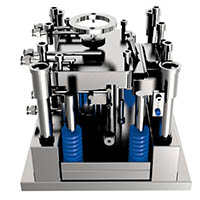Classification of Automotive Mold Processing and Development Analysis of the Automotive Mold Processing Industry
The classification of automotive mold processing and the development analysis of the automotive mold processing industry. With the continuous promotion of information technology, digital technology, and automation skills in the manufacturing industry, automotive mold processing skills are moving towards a more refined, chaotic, efficient, and intelligent direction. At the conference on the production skills and transaction docking of car molds and car parts, all the innovative car mold skills will be showcased in the use of large-scale CNC multi station automated stamping molds, aluminum magnesium alloy sheet stamping molds, high-quality exterior parts such as car watches and interior decorations, car lights, and the latest mold products for new energy cars such as battery molds and transmission device molds.

Three automobile mold processing units:
1. Skills in processing stamping molds for sedans
2. Processing of die-casting molds for variable speed devices
3. Processing of plastic molds for car lights
4. Processing of plastic molds for car interior parts
The development of high-end mold manufacturing systems cannot be separated from the support of the mold profession. At present, China has become a major producer and user of mold processing, but after decades of reform and opening up, the strength of our local mold processing industry still lags behind the world’s top level. Many high-end mold products can only rely on imports to meet domestic industrial demand. This is undoubtedly a tragedy for the development of the national mold industry.
So, in the rapidly developing industrial society, how will the local mold industry rise?
Strengthening the Construction of Intellectual Property Rights in Mold Processing and Improving the Mold Processing Skill Reserve System
Independent research and development is the primary method for companies to obtain independent intellectual property rights, and research and development is also the main driving force for promoting the development of the casting and mold processing industry. However, the ability of independent research and development in China’s mold industry is still very weak. Currently, the primary policy for domestic casting and mold development is still independent research and development. Therefore, as long as the Chinese mold industry completely separates from relying on skills, it can be fundamentally independent.
Therefore, China’s mold processing industry should increase investment in scientific research, actively cultivate scientific research talents, and develop a batch of mold production skills with independent intellectual property rights; Regarding the skill bottlenecks that cannot be broken domestically, it is necessary to actively introduce and digest them.

At the same time, in addition to continuously enhancing the company’s awareness of independent intellectual property protection, government departments are also likely to introduce more incentive and support measures to build an outstanding environment for domestic mold companies to carry out high-end equipment production, and further promote the development of the mold making industry.
Currently, China’s mold processing industry is mostly concentrated in the middle and low-end categories, with low skill levels and added value of molds. Some high-precision molds also rely on imports, so the domestic mold manufacturing industry needs to strengthen integration in various categories. The overall Chinese mold market is a situation where competition and opportunities coexist.
Foreign mold brands are still facing challenges. The competition pressure faced by the Chinese mold processing profession mainly lies in the skill advantages of developed countries and the quotation advantages of developing countries. It is known that the development of industrial molds is not only advancing in China, but also rapidly in Southeast Asian and Eastern European countries in recent years. Their advantages in mold quotation are obvious, which to some extent weakens the cost and quotation advantages of the Chinese mold profession. In addition, the dominance of Japan, South Korea, and Western Europe in high-end mold markets has also put the Chinese mold industry in endless competition.
Domestic demand has driven a significant increase in mold processing output. The development of the domestic automobile mold processing industry, as well as the development policies of new strategic industries, regional development plans, and the revitalization of the equipment manufacturing industry, will provide new growth points for the mold processing industry. With the proliferation of manufacturing industries from developed countries moving towards China, the Chinese mold industry has ushered in a new round of development opportunities. It is speculated that in an environment where both the table and the table are driven, the production and sales value of Chinese molds will reach 1780 billion yuan by 2024.





